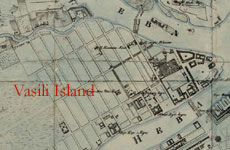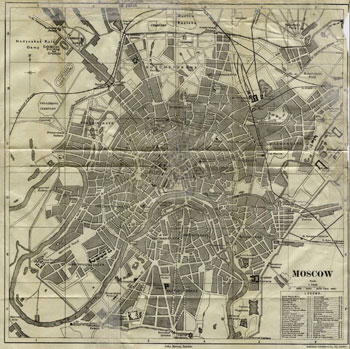
St. Petersburg in 1824 |
This map depicts the flood of 1824. Areas that were underwater are shown in light blue, which indicates the extent of the flooding.
 As you look at this map, you may also notice another distinguishing feature of St. Petersburg: its straight lines and right angles. Many of its streets are set out in a regular grid pattern. This is especially noticeable on the large island situated in the central left section of the map. This is Vasili Island, and much of it was laid out in a strict grid pattern. Across the river Neva from Vasili island sits the mainland, and you’ll notice that the regular grid pattern is repeated in several neighborhoods here as well. As you look at this map, you may also notice another distinguishing feature of St. Petersburg: its straight lines and right angles. Many of its streets are set out in a regular grid pattern. This is especially noticeable on the large island situated in the central left section of the map. This is Vasili Island, and much of it was laid out in a strict grid pattern. Across the river Neva from Vasili island sits the mainland, and you’ll notice that the regular grid pattern is repeated in several neighborhoods here as well.
Compare this with a Map of Moscow from 1893. Moscow began as a small trading post and fortress, and over the centuries grew outward from this central point--the Kremlin, or fortress--in a series of concentric circles. This pattern, in fact, has continued to this day, with a series of highway Ring Roads encircling the city.

Moscow 1893 |
One of the enduring themes of Russian culture since the 18th century is the opposition between Moscow and St. Petersburg. Moscow, the older city, the historical capital of Russia, is depicted as being more organic in its growth and development, more natural, more "Russian" if you will. Petersburg, in contract, was a planned city, dominated by grids and straight lines it’s associated with artifice, with Europeanness, and with a break or rupture from Russian tradition. In "The Bronze Horseman," Pushkin writes of Petersburg overtaking and outshining the old capital city of Moscow. In the introductory section of the poem, Petersburg is described as beautiful and youthful, while Moscow is in decline, portrayed as an old dowager: "before the younger Capital, ancient Moscow has grown pale Like a widow in purple before a new empress" (p. 248 in our course reader).
This is just one small example of this contrast or opposition between Moscow and St. Petersburg, but it's a theme found throughout Russian literature, especially literature since the time of Puskin.
Keep in mind that the flood depicted in the poem, the flood of 1824, is just one in a series of floods Petersburg endured; St. Petersburg was particularly vulnerable to flooding due to its location on the Gulf of Finland and its low elevation. And so another central theme of Petersburg and literature about Petersburg is that of human sacrifice: the vast numbers of serfs and conscripts who perished in the construction of a brand new city in this most unlikely and inhospitable of locations on a swampy marsh; the sacrifices that Petersburg’s residents have had to endure ever since Peter I set out to realize his dream of a city that would serve as a "Window to the West."
|